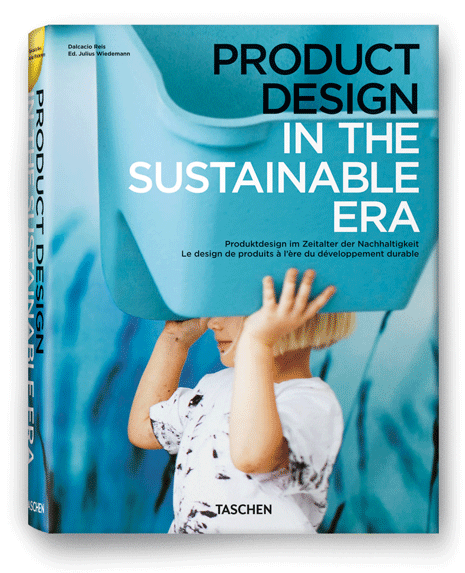
I was so pleased when the postman knocked on my front door this morning to hand me a package from the book publishers Taschen with a review copy of Product Design in the Sustainable Era inside.
I often feel wrought with guilt when I think of how the choices I make as a consumer affect the planet. I mean I try and buy locally and even grow my own produce (although my three strawberries I picked earlier today is hardly going to sustain me), I always reuse my shopping bags at the supermarket, switch off the lights when I leave a room, try to buy products with the least amount of packaging as possible (in fact, just this week I bought a bottle of wine made from PET) and will even opt to buy one brand over another if I know the company has a sound environmental policy. However, I can try and be as green as I like but unless I am given the option of purchasing sustainable products then I can’t really live up to my full ‘eco warrior’ potential. This is where, I think, designers step in and create desirable products that we not only want to buy but are good for the environment too.
This book is a celebration of just such sustainable design and is filled with over 100 projects – whether research projects, concepts or finished products – that are all helping to shape a new era of product development and consumer behaviour. As the book’s author, Dalcacio Reis, a Brazilian product designer, says in his introduction: “We are living in a time of transition. This is a time when people are becoming more concerned about and more conscious of the repercussions of their everyday behaviour, such as turning on a tap, switching on a light or even a quick trip to the supermarket. The choices we make, especially now, can directly or indirectly influence an enormous chain of events which, in turn, could have a negative or positive impact on our planet and on our lives.”

Divided into eight chapters (namely Electronics, Energy, Furniture, Home & Appliances, Lighting, Retail Products, Sports & Apparel and Miscellaneous) the book covers a wide range of projects from an environmentally friendly desktop PC, a solar powered bus shelter, chairs made from remnants of the injection moulding process, indoor composters, woollen storage bowls, a vacuum cleaner made from recycled plastic, wind-powered outdoor lighting, compostable water bottles, natural-organic surfboards, solar-powered rucksacks, hemp shoes coated with bee’s wax, a bamboo guitar to, probably most bizarrely of all, a biodegradable cardboard coffin (perhaps so that you can go to your grave with peace of mind). So, the projects are very varied and although some aren’t yet realised they are all innovative solutions in a world where our landfills are bursting and we need alternatives to our conspicuous consumption. Each project is dedicated a double page spread and in a paragraph or two describes what it is as well as giving information as to the inspiration and motivation behind it, materials and resources used, as well as the eco-friendly manufacturing processes employed during its development.

So, although I am yet to read the book from cover to cover and pour over all the projects presented within its pages, I will leave you with this question posed in the book’s opening pages by Leif Huff, managing director at IDEO Munich, to ponder over: “Designers are in the business of making stuff. When done well, this makes people consume more in order to help businesses grow. This simple equation used to be the very definition of successful design, but it was also, in many cases, undeniably narrow-minded as well, helping to encourage a culture of consumption that currently threatens literally to consume itself. So how is the designer’s role evolving as our world-view expands to consider some very big questions about the fate of our planet?”







